Top questions about the Woodlawn Advanced Energy Recovery Centre
Our FAQ's are regularly updated to include the questions we receive from the community. If there is something you'd like to know that is not covered in the below, please get in touch with us.
Energy from waste
What is ‘energy from waste’?
Creating energy from waste, also known as ‘energy recovery’, is the process of converting the residual waste that cannot be recycled into sources of energy such as heat, fuel, and electricity.
How are non-recyclable materials converted into sources of energy?
Energy recovery from waste works similarly to conventional coal or gas combustion, where the resulting steam is used to run a turbine to produce electricity. Instead of using fossil fuels, energy from waste technology has been adapted to use non-recyclable waste materials. Three tonnes of waste replaces one tonne of coal and is 50% biomass, delivering a low-carbon energy alternative, whilst reducing the need for landfill. Veolia has the global expertise to safely deliver this technology.
It works by:
- Waste is dried and combusted in a controlled air flow environment at more than 850°C
- This high intensity combustion generates heat which produces steam
- The steam drives a turbine to generate electricity for export to the local power grid
Who else is using this technology?
Energy from waste technology is being used safely in many countries around the world, with over 450 facilities operating in Europe alone. Veolia owns and operates more than 65 energy recovery facilities globally, and has also been chosen to operate Australia’s first two facilities: Kwinana and East Rockingham, both of which are currently under construction in Western Australia.
Does energy recovery deter people from recycling?
While energy recovery plays an important role in capturing value from non-recyclable items, it should not be thought of as an alternative to material reuse and recycling. It is important that people understand that where we cannot first avoid generating waste, we should always recover whatever we can through reuse and recycling, followed by energy recovery.
When we look at evidence from other countries around the world, those who use energy recovery as part of an integrated waste management system maintain very high recycling rates. For example, in 2017 Switzerland recycled 53% of its waste and recovered energy from 47%.
The below graph demonstrates that there is a strong positive relationship between Energy from Waste and recycling. This means there is a correlation between the integration of Energy from Waste into a country's waste management system and higher recycling rates.
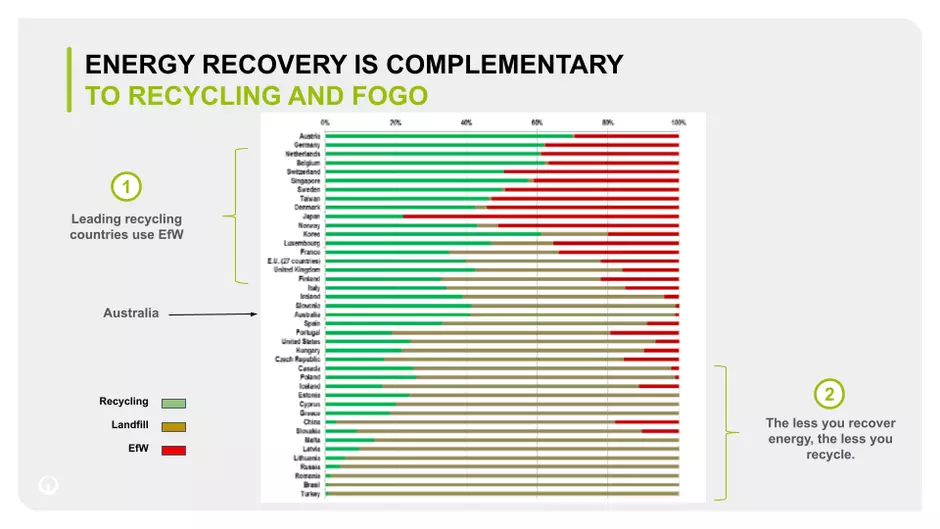
How does energy recovery differ from incineration?
There is a big difference between incineration and an energy recovery facility. Incineration is the process of burning waste without controls, whereas an energy recovery facility is a state of the art facility in which the residual waste is combusted and then maximises that process in a highly controlled environment. An additional element is the recovery of energy through the combustion process, in addition to the flue gas process which is critical to answer the question of how we are different to an incinerator.
Why is energy recovery an important solution for non-recyclable waste?
Waste that cannot be recycled can be turned into a valuable resource, like energy for local homes, when it is recovered properly. Recovering energy from non-recyclable residual waste is currently the most sustainable way to manage non-recyclable material.
If you look at the waste hierarchy, you can see that after first avoiding waste, reusing it, and then recycling it, the recovery of energy should be utilised next as a preferred treatment option. Landfilling (or ‘disposal’) of waste is the least preferred waste management option because it doesn’t allow for the recovery of materials.
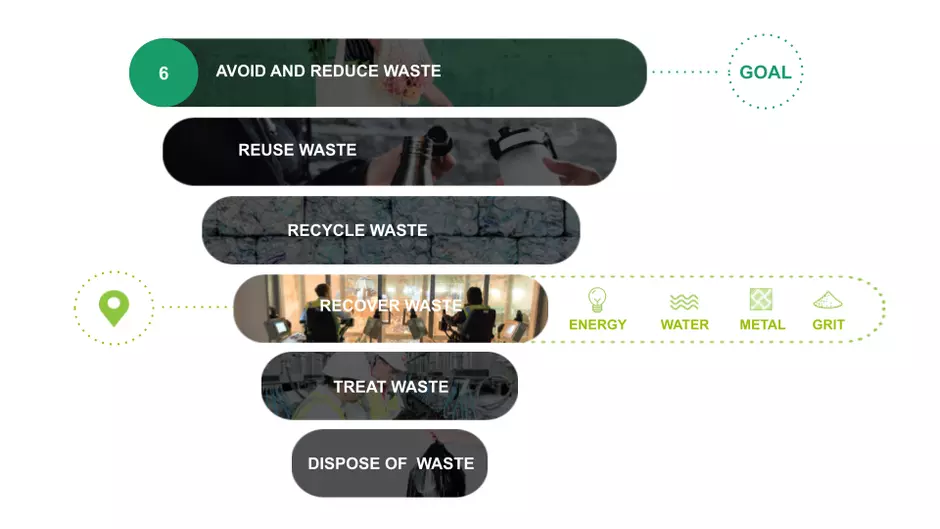
Where can I find independent research on the effects of energy recovery?
If you'd like to read further about Energy from Waste, please have a look at the studies linked below:
- The Impact on Health of Emissions to Air from Municipal Waste Incinerators
- Scientific Truth About Waste-to-Energy
- On Municipal Waste Incineration
- Fetal Growth, Stillbirth, Infant Mortality and Other Birth Outcomes Near UK Municipal Waste Incinerators
- Risk of Congenital Anomalies Near Municipal Waste Incinerators in England and Scotland
What is the circular economy, and why is this important?
The circular economy is an economic model that considers waste as a resource, keeping products and materials in use to support better, repeated and more sustainable use of our resources. A circular economy has environmental and economic benefits, and is a guiding principle of the Australian Government’s National Waste Policy Action Plan 2019.
Proposal & planning for the ARC
What is Veolia proposing?
Veolia is proposing to build an Advanced Energy Recovery Centre (ARC) at the Woodlawn Eco Precinct. The ARC will take waste that cannot be recycled and turn it into energy, producing enough electricity to power more than 40,000 homes per year.
Why are you proposing to build at the Woodlawn Eco Precinct?
The ARC is the next phase in Veolia’s long-term vision for the Woodlawn Eco Precinct. Building the facility at the Eco Precinct will be an important part of Veolia’s continued investment in regional New South Wales, which is creating hundreds of jobs, driving economic growth and supporting Australia’s environmental shift towards a circular economy.
Expanding our operations to include the ARC will deliver:
- Over $600M initial investment in regional NSW and a further $2b investment in lifetime maintenance and employment
- Further recovery of non-recyclable waste, diverting 380,000 tonnes from landfill (enough to fill 172 Olympic swimming pools)
- Generating 30MW energy, enough to power 40,000 homes per year
- Further investment in community initiatives, and ongoing enhancement of the local environment
- 300 jobs during construction and 40 jobs during operation
How much will it cost? Who is paying?
The ARC is planned to cost $600 million, which will be funded by Veolia.
Has Goulburn Mulwaree Council been zoned as a priority area for energy recovery?
The NSW Government has recognised the Southern Goulburn Mulwaree Precinct as one of four Priority Infrastructure Areas for the development of Energy from Waste facilities.
What will the proposed facility look like?
Veolia's proposed Advanced Energy Recovery Centre (ARC) will be state-of-the-art. It is our intention to ensure the technology we deploy is best in class, and that the ARC's aesthetics are just as impressive as the technology used to recover energy!
The site design site is not finalised, however Veolia is actively considering the environment in the overall concept. This includes operational features, ensuring efficiency can be achieved without compromising the health of our planet, and an attractive design that compliments Tarago's surrounding greenspace. We will include as much as the natural landscape in our concept as possible.
The below are artist impressions that will continue to be evolved throughout the planning process, where we will invite formal feedback from the public on our proposed facility.
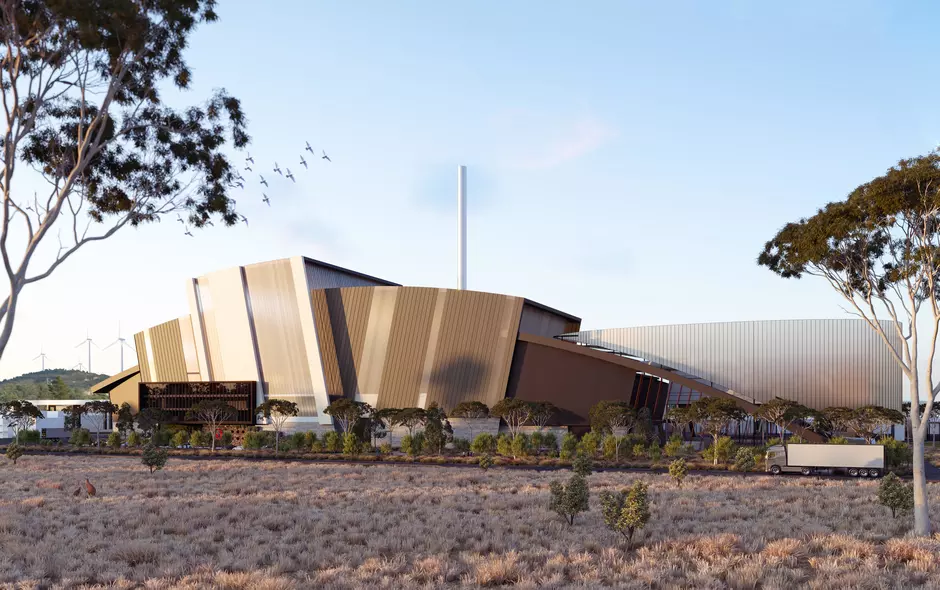
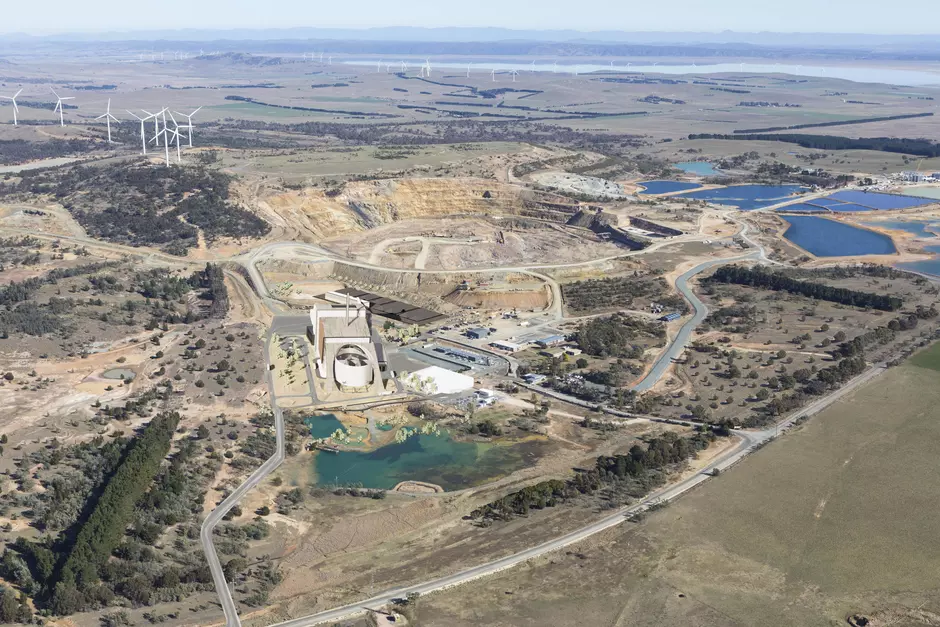
Amendment to the project
What is a Project Amendment?
An applicant can apply to amend or vary an application at any time before it is determined if they want to change the project description from that provided in the EIS to improve the design of the project, respond to issues raised by the community in public submissions or further mitigate the impacts of the project.
What is an Amendment Report?
An Amendment Report assesses the economic, environmental and social impacts of the amended project to help the community, Councils, Government agencies and the Consent Authority gain a better understanding of the proposed amendment(s) and their impacts and make informed decisions on the merits of the amended project.
The DPHI has guidelines for preparing an Amendment Report which can be found here.
Will this amendment be exhibited?
The Department of Planning, Housing and Infrastructure (DPHI) will decide whether the changes set out in the Amendment Report warrant public exhibition. The Amendment Report will be published on the DPHI’s website. Veolia expects that a public exhibition process is likely and is committed to fully and transparently explaining all aspects of the amendment to the community.
Will this amendment change the timeframe of the approval process?
Yes it will extend the process. As noted above a public exhibition is likely and then the DPHI will ask Veolia to respond to submissions made on the Amendment Report. After this the DPHI will prepare their assessment report which will be forwarded to the Independent Planning Commission who will make a decision on the development application for the project.
What is APCr?
APCr is a by-product captured by air pollution control systems from energy recovery facilities (more commonly referred to as fly ash). Typically, it includes a mixture of ash, carbon and lime.
What is Veolia’s amendment to the ARC Project?
The following amendments are proposed:
- Removal of the previously proposed Encapsulation Cell from the project
- Changes to the stabilisation process used to treat the APCr
- Relocation of the APCr stabilisation area which will now be adjacent to the main EfW building
- A contingency will also be included in the Amendment Report which provides for the transport of the stabilised APCr to an off-site facility for disposal. This will provide for disposal of the stabilised APCr should it not meet the standards required for disposal at the Woodlawn Bioreactor
Is the stabilisation process completely different to the original process for the APCr?
The flue gas treatment and filtration is exactly the same. The stabilisation process is very similar but rather than using Portland cement as a stabiliser, other fillers and binders would be used. Veolia is still investigating the preferred options.
Have the proposed stabilisation methods been used elsewhere?
Yes, the proposed APCr stabilisation methods have been implemented at various sites internationally. Veolia has identified three specific methods that are currently in use at various facilities worldwide:
- Carbonation: the process of creating manufactured limestone aggregates, which has been successfully employed in multiple countries.
- Chelation: a well-established technique to immobilise metals in APCr through the use of chelating agents.
- Physico-chemical treatment: utilising acids and binders to chemically treat and stabilise APCr.
Veolia is currently evaluating and seeking feedback on these stabilisation options to determine which method is most preferred.
How do the proposed changes to the project affect the community, safety, pollution, and overall risk?
The proposed changes to the project are expected to reduce risks, while maintaining or enhancing environmental protection and addressing community concerns. To elaborate on how these changes affect various aspects:
Community Impact: The Proposed Amendment addresses community concerns regarding the encapsulation cell and site water management. An addendum Social Impact Assessment is being prepared which will evaluate effects on the local community, examining both direct and indirect impacts on residents and stakeholders.
Safety: The ARC’s primary functions and flue gas treatment remain unchanged, with the amendments focusing on residual material management. Each batch of stabilised APCr will be tested to ensure it meets general solid waste classification before disposal. The proposed stabilisation processes have been successfully implemented in facilities worldwide. This amendment not only addresses previous community concerns about the encapsulation cell but also provides a more operationally feasible solution.
Pollution: The Environmental Impact Statement (EIS), including the air quality impact assessment (AQIA) and human health risk assessment (HHRA) studies predict no impacts of concern, including when considering the amendment. These studies have been undertaken based on highly conservative assumptions, looking at worst case scenarios and for the HHRA looking at impacts over a 70-year period even though the ARC will only operate for a 20 to 25 year period.
Risk: The elimination of the hazardous waste encapsulation cell significantly improves the project's risk profile. By treating APCr to produce GSW, the project achieves a more stable, non-hazardous end product that is safer to manage and store.
- Amendment has eliminated dust from the encapsulation cell and its transport.
- APCr stabilisation will be moved to an enclosed facility.
- A detailed Hazard and Risk Assessment will evaluate all project risks and establish appropriate control measures and contingencies.
Further information will be provided in the upcoming amendment report and associated studies.
What are the economic benefits of this project for our community?
- Employment Opportunities:
- The project will generate 300 construction jobs, followed by 40 direct operational positions and 80 indirect jobs in supporting industries, plus 10 new jobs linked to the stabilisation process activities. Veolia's commitment to local hiring ensures these employment opportunities directly benefit local residents.
- Regional Economic Growth:
- The project will inject $7 million annually into household income and generate $37 million in annual business turnover. With $2 billion invested over 25 years of operations, with a focus on using local suppliers, the project will significantly boost the regional economy.
- Community Investment:
- Through the Veolia Mulwaree Trust, $14.5 million has supported over 1,500 community projects. Additional contributions include $14 million to Goulburn Mulwaree Council and $2 million to Queanbeyan Palerang Council. Through the ARC project Veolia is committed to continuing our support of local community projects.
- Long-term Economic Benefits:
- Economic assessments confirm significant regional benefits during both construction and operation. Veolia's ongoing commitment to supporting local businesses, community groups, and events ensures lasting positive impacts for the region's economic future.
How is Veolia addressing risks?
The stabilisation process has been safely in operation at a number of facilities globally.
All potential risks identified (however unlikely) are addressed in the Risk Assessment process and recommendations made to:
- Eliminate the risk by removing the hazard.
- Substitute the hazard with something less dangerous.
- Redesign the process to something safer.
- Isolate the hazard from people.
- Manage the risk by the use of policies, practices, rules, signage and training.
- Protect people by the mandated use of PPE.
What are the contingency plans if the APCr stabilisation method doesn’t work?
As a contingency measure, Veolia has included provisions in the Amendment Report for off-site transport and disposal of stabilised APCr. If any batch of stabilised APCr doesn't meet the general solid waste (GSW) classification required for disposal at the Woodlawn Bioreactor, it will be transported off-site for disposal at an appropriately licensed waste management facility as restricted solid waste (RSW). This backup plan ensures that Veolia has a robust and reliable solution for APCr management.
Why did Veolia have more time to prepare their response to feedback compared to the community’s opportunity to respond to the EIS?
We understand your concerns about the project timeline, and would like to provide some context on the project application process.
Project exhibition timeframes are set by the Department of Planning. The standard timeframe for Environmental Impact Statement (EIS) community submissions is 4 weeks, and in the case of the ARC this was extended to 7 weeks.
Since the EIS exhibition in late 2022 we have been diligently reviewing all of your submissions, and conducting additional technical studies to ensure our response is accurate and well-informed, taking into consideration your feedback throughout our research. This process is designed to address the concerns raised by the community, and to enhance the overall project plan.
We are currently in the final stages of preparing the EIS Submissions Report and Amendment Report, which will reflect the findings of these further studies. Once completed, these documents will be shared with the community for review and the ARC project team will organise further community events to gather your feedback.
How do you account for the time community members spend engaging with the project?
We greatly value and appreciate the time community members invest in engaging with the project. Veolia's community engagement process has always been conducted on a voluntary basis, which is standard practice for major infrastructure projects and ensures genuine, independent community input. Your feedback is essential in shaping project outcomes.
Project benefits
Will there be any new jobs for the local community?
Yes, we will employ people from the local community wherever we can. There will be 300 jobs created during construction and 40 ongoing jobs during operation. In addition to this, it is projected that 383 indirect jobs will be created through spending with local suppliers and businesses. We will also be investing in apprenticeships at the site such as boiler makers, mechanics and electricians.
How much will this project invest locally?
The economic assessment for the EIS found that the project will provide significant benefits to the regional economy during both its construction and operation.
Capital investment to build the ARC will be $600 million. A further $2 billion will be spent on operations and maintenance over the life of the project.
$227 million will be the annual boost to the regional economy from spending with local suppliers during construction (i.e. building materials, transport, catering, security). The regional economy will be supported by the spending of an estimated $45 million in local shops and businesses during operation. (i.e. pubs, hotels, restaurants, supermarkets etc).
Overall, household incomes in the region will increase by $45 million during construction with a $7 million annual boost during operation.
You can read the full economic impact assessment in Chapter 8.15 of the EIS.
How will the ARC contribute to delivering a circular economy?
The ARC will divert up to 380,000 tonnes of waste from landfill each year and in the process will recover or recycle up to 96% of the resources that would otherwise be lost. These resources include recyclable metals, non-hazardous bottom ash (stones, grit, glass and rocks) which will eventually be recycled into construction aggregate, and the generation of electricity produced by steam.
For more information on the project's benefits, review our benefits fact sheet below:
Environmental Impact Statement (EIS)
What is an Environmental Impact Statement (EIS)?
The ARC project is classified as a State Significant Development, which is typically considered a development which has significance to the State of NSW based on a range of factors including size, nature, location, strategic importance, or potential impacts.
All State Significant Developments are required to complete a comprehensive assessment process, including providing an Environmental Impact Statement (EIS). The purpose of an EIS is to assess the economic, environmental and social impacts of a project. It helps to inform the project’s various stakeholders (including community and government agencies) of its merits and potential impacts, so that they can make an informed decision with regard to the project’s progress.
As part of the planning process, the EIS is publicly exhibited so that stakeholders can review the technical assessments in detail and provide their feedback to the Department of Planning and Environment (DPE). The DPE will then complete its assessment of the proposed project based on the its merits and the feedback provided.
Where can I view the full EIS?
The full EIS is available until Tuesday 13 December. It can be accessed digitally on the Department of Planning and Environment’s website.
Is there a shortened version of the EIS?
Yes, we recommend reading our Community Guide to the EIS for a comprehensive overview of the ARC proposal and the results from its EIS assessments.
I would like to hear from the independent experts who conducted the air quality and health assessments
Watch independent air quality and human health experts' interviews to learn more about their assessments and results here.
Health & safety
Is energy recovery safe for people?
Yes, the energy from waste process is well regulated and proven to be safe. Veolia is an expert in energy from waste and has the expertise to safely deliver the technology. Veolia owns and operates more than 65 energy recovery facilities globally and has the expertise to meet the strict environmental standards set by the NSW Environment Protection Authority.
Independent air quality and human health assessments have been completed as part of the project’s Environmental Impact Statement (EIS). The results from these assessments have concluded there will be no negative impacts to air quality, human health, or the surrounding environment. The EIS is now publicly available for review on the Department of Planning and Environment website. More information on the Air Quality and Human Health assessments can be found here.
Will there be impacts to livestock or crops?
No, there won't be noticeable impacts. The independent environmental impact assessments consider local flora and fauna, and as part of this process we had to demonstrate that there is no unsafe impact. The findings of these studies have shown there will be no negative impacts on crops or livestock, and that suppliers will not have to make changes to their produce labelling.
Is energy recovery safe for the environment?
All energy recovery facilities operate to strict environmental regulations, which ensure minimal impact on the environment. Pollution prevention control systems will be installed at the ARC with the results closely monitored by our operators and the Environment Protection Authority, to ensure that any emissions produced are within our operational licence limits. All details of these regular reports will be published on the public register.
What are the possible environmental impacts?
Studies have been conducted to determine the environmental, economic, and social impacts of the project. The results of these studies conclude that there will be no impact on the surrounding environment.
What would happen if an air pollution control device failed?
This computer network has a backup system, with extra resources available to support the main system. Any device identified as faulty will be isolated and replaced online. If the fault cannot be corrected online the shutdown process of the ARC would commence.
Air quality
How was the Air Quality Impact Assessment conducted?
Three emission scenarios were developed for which potential air quality impacts were modelled. Two of these included ‘reference case’ scenarios using real-world emission data over a 12-month period from a Veolia-owned Energy from Waste facility in Staffordshire, United Kingdom. The first scenario using the reference case examined expected emissions from the ARC under normal operating conditions, and the second represented maximum (‘worst case’) emissions from Staffordshire. The third scenario represented a ‘regulatory case’ which adopted the new emission limited as outlined in the NSW Energy from Waste Policy Statement.
What did the results show?
For all scenarios, it was found that the introduction of the ARC will not significantly change air quality conditions currently associated with the Woodlawn Eco Precinct. It was also shown that air quality impacts associated with the Eco Precinct are negligible at surrounding sensitive locations including homes, farms, and the local school.
The graph below demonstrates that the addition of the ARC will have negligible impact on current air quality, and that all emission concentrations will remain well within the safe standards as outlined by the NSW EPA.
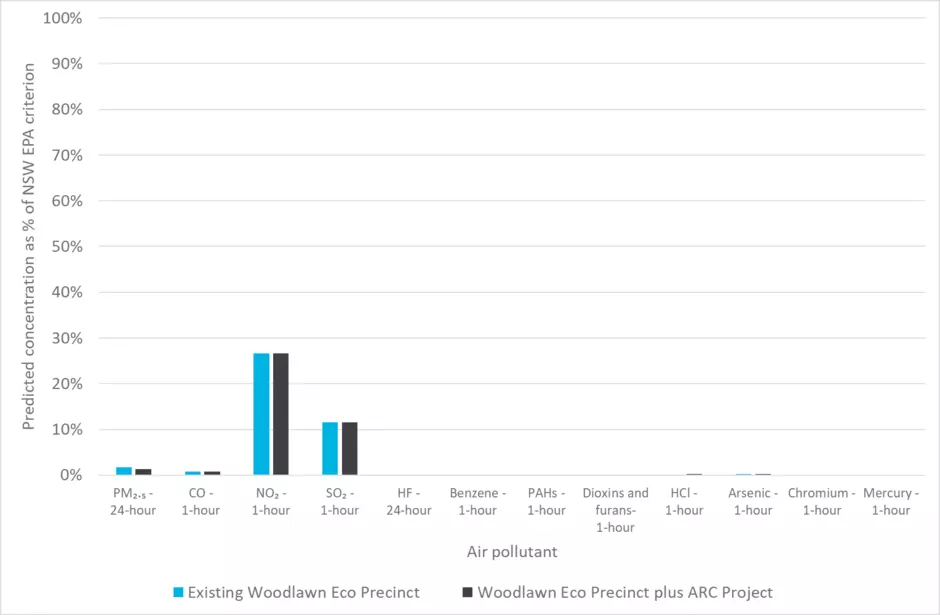
Will the introduction of the ARC impact air quality?
If approved, the ARC will be held to a set of criteria outlined in the NSW Government’s Energy from Waste Policy Statement, which is stated to be the most stringent in the world. The facility will also be subject to independent oversight and regulation by the NSW Environment Protection Authority (EPA) for the lifetime of its operation.
As part of the ARC’s planning the proposal underwent a number of independent assessments including an Air Quality Impact Assessment, and a Human Health Risk Assessment. The findings from both assessments reflected that there would be no significant changes to air quality, and no impact on health as a result of the introduction and operation of the Woodlawn ARC.
I would like to hear from the independent expert who conducted the Air Quality Impact Assessment
Watch the video below to learn more about the Air Quality Impact Assessment, how it was conducted, and its results, from independent technician Scott Fishwick.
Will there be real-time monitoring of the emissions?
Yes, real-time monitoring will be in place 24/7.
More information on the air quality assessment can be found in Chapter 8.1 of the EIS.
Human health
How was the Human Health Risk Assessment conducted?
The assessment looked at the various ways people could potentially be exposed to emissions both in the short and long term, and whether or not this might impact human health. The results were calculated for all sensitive locations in the surrounding community, using guidance detailed by enHealth (2012) and NSW Chief Scientist (2020).
What did the results say?
The Human Health Risk Assessment concluded that in all scenarios in which a person may be exposed to emissions, concentrations remained well within all health guidelines and as a result there is no adverse risk to human health.
The graph below shows the predicted maximum exposure to emissions from the ARC. The limit of 1 represents the maximum acceptable risk, or Hazard Index (HI). The graph shows the calculated risks are well within acceptable limits. A micro-view of the dioxins and furans level is also provided on the right.
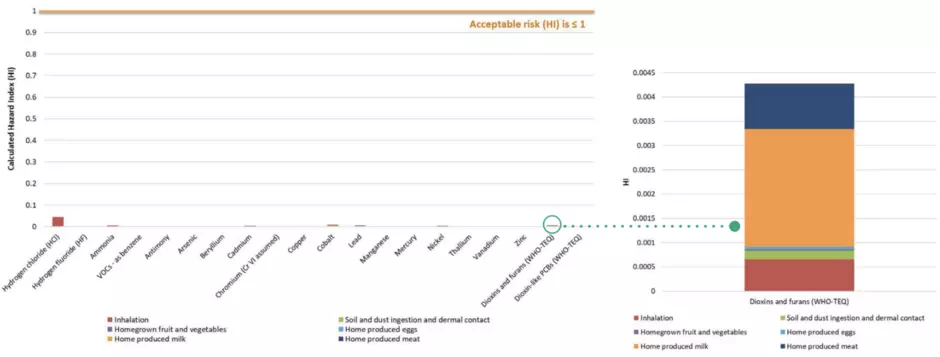
Will water quality be affected by the project?
The Human Health assessment considered impacts to quality of water in rainwater tanks at residential and rural properties near the site. It also looked at the impact on groundwater quality and recreational water quality in Lake George and Lake Bathurst. The assessment concluded that predicted water concentrations in rainwater tanks will remain well within drinking water guidelines and will be safe to drink. It will also remain safe to source drinking water from groundwater, and the water quality of the lakes will not be affected by the project.
The graph below shows the maximum concentrations in rainwater tanks as a percentage of the Australian Water Guideline. It shows that concentrations from the ARC are well within safe drinking water limits for human health. In fact, the concentrations are predicted to be so low that they would not even be detectable using the best available analysis technology.
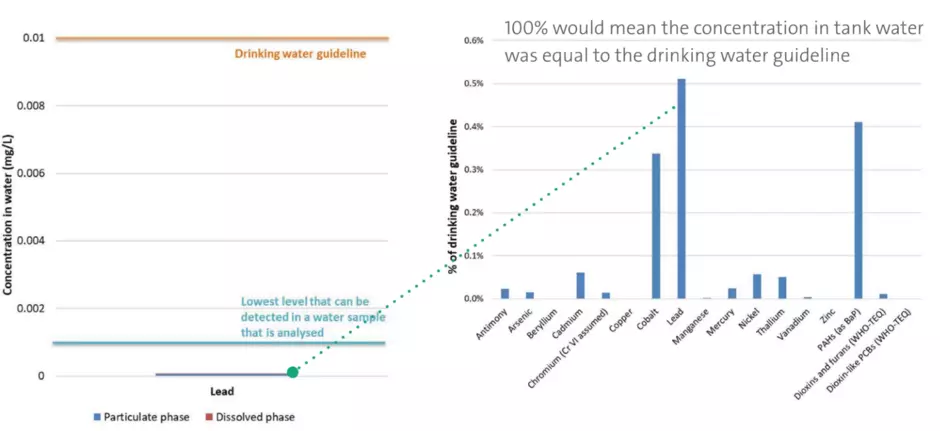
Will crops and livestock be affected?
The assessment looked at potential impact of air emissions from the ARC on crops and produce grown in the area. The results have shown that there would not be any measurable change in soil quality as a result of emissions, nor would the project change existing soil conditions or water quality. Farms with organic farming status would not be affected.
The consumption and sale of produce from the area was also considered, and results show that even the maximum predicted concentrations in local produce would be well below limits prescribed in Australian food standards.
I would like to hear from the independent expert who conducted the Human Health Risk Assessment
Watch the video below to learn more about the Human Health Risk Assessment, how it was conducted, and its results, from independent technician Dr Jackie Wright.
More information on the human health assessment can be found in Chapter 8.2 of the EIS.
Farming
I eat fruit, vegetables, and animal products grown in my garden and locally. Will the ARC affect the quality of my food?
All kinds of food grown locally will remain safe for consumption, as detailed by the Human Health Risk Assessment (Section 8.2 of the EIS). The assessment considered the cumulative ingestion of produce such as eggs, milk, meat, fruit, and vegetables, combined with exposure to air emissions from inhalation, water consumption, and contact through recreational activities.
Will the quality of my livestock be affected?
No, the quality of meat and animal products will not be affected by the ARC’s operation. The Human Health Risk Assessment found that there would be no impact to livestock or their products as a result of the ARC, and that they will remain well below the limits set by the Food Standards Code for Australia. More information on the Human Health Risk Assessment can be found in Section 8.2 of the EIS.
Will soil or crop quality be impacted?
No. The Human Health Risk Assessment found that “emissions from the project would not result in any measurable change in soil quality in the area. Hence the project would not change existing conditions or result in impacts on crops grown on farms with organic farming status.” (Section 8.2.3.a of the EIS)
Will I maintain my organic farming status?
Organic farming status will not be affected by the addition of the ARC, and farmers will continue to be able to label their products as organically grown.
Energy from Waste technology
How does energy recovery work?
Energy recovery from waste (or 'Energy from Waste') works similarly to conventional coal or gas combustion, where steam is produced from the heat and is then used to run a turbine which generates electricity. Instead of using fossil fuels, Energy from Waste technology has been adapted and updated to use non-recyclable waste materials. Three tonnes of waste replaces one tonne of coal and is 50% biomass, delivering a low-carbon energy solution whilst reducing the need for landfill.
For more information, download our Energy from Waste fact sheet, or watch our 'How does Energy from Waste work?' video below.
How does energy recovery differ from incineration?
There is a big difference between incineration and an energy recovery facility. Incineration is the process of burning waste without controls, whereas an energy recovery facility is a state of the art facility in which the residual waste is combusted and then maximises that process in a highly controlled environment. An additional element is the recovery of energy through the combustion process, in addition to the flue gas process which is critical to answer the question of how we are different to an incinerator.
Who else is using this technology?
Energy from waste technology is being used safely in many countries around the world, with over 450 facilities operating in Europe alone. Veolia owns and operates more than 65 energy recovery facilities globally, and has also been chosen to operate Australia’s first two facilities: Kwinana and East Rockingham, both of which are currently under construction in Western Australia.
What other outputs will there be, and how will they be managed?
In addition to the energy produced, three other materials are recovered during the process:
- Bottom ash. Non-combustible material such as stones, grit, glass and rocks, can be recycled as aggregates for use in the construction industry;
- Air pollution control residues. Fine dust is filtered, captured and managed on site; and
- Ferrous and non-ferrous metals will be recovered from the bottom ash and recycled into new items.
Facility construction
When will the ARC be built?
If approved, construction of the project is expected to be undertaken over a period of about three years, starting around late 2023.
What will the facility look like?
Veolia has taken into account a range of considerations for the facility’s design, including integrating the appearance into the surrounding natural landscape to limit visual impact, using sustainable materials, and using its form and orientation to capitalise on natural heating and cooling variations in the environment.
The ARC will be partially obscured from outside the site’s boundary with the aid of tree cover and the natural landform. The Environmental Impact Statement (EIS) has concluded that the ARC’s introduction would have no significant visual impact on the existing landscape. More information can be found in Appendix BB of the EIS, available on the Department of Planning and Environment website.

Where on the site will the facility be located, and how large will it be?
The ARC will be located in an area of the old mine that requires remediation. Installing the new facility will help remediate a former mining site and help return the land to valuable use. The site for the ARC will be approximately six hectares. More information on the ARC's design can be found in Chapter 4 of the EIS.
Facility operations
How long will the ARC operate for?
The ARC will be in operation for 25 years.
How much waste will the ARC process?
The ARC will be able to process up to 380,000 tonnes per year (which is equal to 172 Olympic swimming pools).
Will tonnages be increased?
Veolia will not need to apply for an increase to its existing waste capacity approval to operate the facility. If an increase to waste volumes is needed in the future, we would be required to apply for an amendment to our existing waste operation consent. At that time we would be required to assess all the impacts afresh and carry out consultation with the community about any such changes.
What type of waste will the ARC process?
The ARC will manage only household waste, the same as what we currently process at the bioreactor. If the wrong items are disposed of, we will endeavour to remove them at the transfer station prior to transfer to the ARC.
How much energy will the ARC produce?
The ARC will generate an additional 30MW of renewable low-carbon energy, which is enough to power 40,000 homes. This will help to take pressure off the grid and compliment the nation’s low-carbon focus.
Will the doors to the site remain closed when they are not being used?
The doors will be automated and only open when the trucks are located near the entry into the tipping hall.
How will Veolia manage groundwater usage at the ARC?
Veolia has access to a groundwater bore and holds a groundwater extraction licence for its current operations at the Woodlawn Eco Precinct. Water usage for the proposed ARC project will be managed within these existing licence approvals.
What are the proposed operational hours for the ARC?
The ARC will maintain the same waste delivery hours as the existing Woodlawn Eco Precinct, with waste receivable between 6am to 10pm, Monday to Saturday.
Operationally, energy recovery facilities operate just like a power station, 24/7. You are only required to shut them down during the planned routine maintenance shutdown.
Traffic
How would the waste be delivered to the ARC?
Our current method of waste transportation to the Woodlawn Eco Precinct will not change. Veolia will use rail to transport the waste to Crisps Creek IMF, which is then transported the short distance to site via trucks.
Will there be any additional rail or truck movements?
The number of rail and truck movements permitted at the Woodlawn site is based on the annual waste input rate. The new facility will not require any increase to the approved annual input rate. There will be some minor additional traffic movements associated with the project during operation, such as employee access and delivery of materials, but with no significant impact on the local road network.
Will you be upgrading the intermodal at Crisps Creek?
There is no immediate need to make any changes to the Crisps Creek rail intermodal facility (IMF); however, we will continue to regularly review this.
You can read more about how traffic and transport will be managed for the project in Chapter 8.5 of the EIS.
Odour
Will the ARC produce odour?
The ARC process will not produce odour.
Residual waste delivered to the ARC will be managed and treated inside a fully enclosed facility, unlike the existing open-cut bioreactor landfill site. The waste that is delivered to site will also be immediately loaded for processing. This will help to contain and manage odour from new wastes.
What are you doing to solve the current odour issue?
An odour management plan is being implemented to include both minor and major activities. The Woodlawn ARC would not produce an additional source of odour from the Eco Precinct site. Upcoming odour reduction works involve:
- Reducing the active tipping face surface area to reduce potential for odour emissions. We also cover the waste area with soil on a daily basis to help reduce odour.
- Optimisation of the biofiltration system, which filters the landfill gas that escapes through the rock wall/waste interface.This will reduce the odorous compounds.
- Maintaining evaporation of stored treated leachate on site through installation of additional evaporation units.
- Installation of a hydrogen sulphide sensor and meteorological station in Tarago. Data will be correlated against instances of odour.
You can read more about our existing operation by visiting the Woodlawn Eco Precinct page.
Community engagement
What engagement activities were undertaken prior to the EIS?
Veolia has had ongoing engagement with the local community around Woodlawn for over 20 years and prides itself on being a valuable contributor to the area. Veolia organised a wide range of community events and engagement activities throughout the planning process of the ARC and during preparation of the EIS, including stakeholder consultations, community information sessions, media coverage, distribution of community newsletters, and receiving and responding to community feedback. An overview of these activities can be found on page 24 of the Community Guide to the EIS by following the button below, or in Chapter 7 of the EIS.
Who do I contact if I have more questions?
Further information on the project can be found at anz.veolia.com/TheArc.
If you have questions, please contact our team on the project information line 1800 313 096 or email us at [email protected]. You can also write to us at PO Box 171, Granville NSW 1830 (responses may take up to a few weeks to process).


